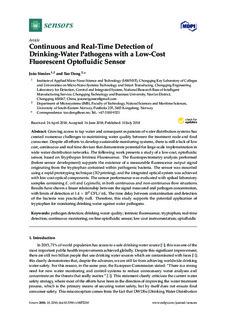| dc.contributor.author | Simôes, Joâo | |
| dc.contributor.author | Dong, Tao | |
| dc.date.accessioned | 2019-01-30T07:47:42Z | |
| dc.date.available | 2019-01-30T07:47:42Z | |
| dc.date.created | 2018-10-27T14:10:15Z | |
| dc.date.issued | 2018 | |
| dc.identifier.citation | Sensors. 2018, 18 (7), 1-14. | nb_NO |
| dc.identifier.issn | 1424-8220 | |
| dc.identifier.uri | http://hdl.handle.net/11250/2582966 | |
| dc.description | This article is an open access article distributed under the terms and conditions of the Creative Commons Attribution (CC BY) license | nb_NO |
| dc.description.abstract | Growing access to tap water and consequent expansion of water distribution systems has created numerous challenges to maintaining water quality between the treatment node and final consumer. Despite all efforts to develop sustainable monitoring systems, there is still a lack of low cost, continuous and real time devices that demonstrate potential for large-scale implementation in wide water distribution networks. The following work presents a study of a low-cost, optofluidic sensor, based on Trypthopan Intrinsic Fluorescence. The fluorospectrometry analysis performed (before sensor development) supports the existence of a measurable fluorescence output signal originating from the tryptophan contained within pathogenic bacteria. The sensor was mounted using a rapid prototyping technique (3D printing), and the integrated optical system was achieved with low-cost optical components. The sensor performance was evaluated with spiked laboratory samples containing E. coli and Legionella, in both continuous and non-continuous flow situations. Results have shown a linear relationship between the signal measured and pathogen concentration, with limits of detection at 1.4 × 103 CFU/mL. The time delay between contamination and detection of the bacteria was practically null. Therefore, this study supports the potential application of tryptophan for monitoring drinking water against water pathogens. View Full-Text
Keywords: pathogen detection; drinking water quality; intrinsic fluorescence; tryptophan; real-time detection; continuous monitoring; on-line optofluidic sensor; low-cost instrumentation; optofluidic | nb_NO |
| dc.language.iso | eng | nb_NO |
| dc.rights | Navngivelse 4.0 Internasjonal | * |
| dc.rights.uri | http://creativecommons.org/licenses/by/4.0/deed.no | * |
| dc.title | Continuous and real-time detection of drinking-water pathogens with a low-cost fluorescent optofluidic sensor | nb_NO |
| dc.type | Journal article | nb_NO |
| dc.type | Peer reviewed | nb_NO |
| dc.description.version | publishedVersion | nb_NO |
| dc.rights.holder | © 2018 by the authors. Licensee MDPI, Basel, Switzerland. | nb_NO |
| dc.source.pagenumber | 1-14 | nb_NO |
| dc.source.volume | 18 | nb_NO |
| dc.source.journal | Sensors | nb_NO |
| dc.source.issue | 7 | nb_NO |
| dc.identifier.doi | 10.3390/s18072210 | |
| dc.identifier.cristin | 1624113 | |
| cristin.unitcode | 222,58,4,0 | |
| cristin.unitname | Institutt for mikrosystemer | |
| cristin.ispublished | true | |
| cristin.fulltext | original | |
| cristin.qualitycode | 1 | |

